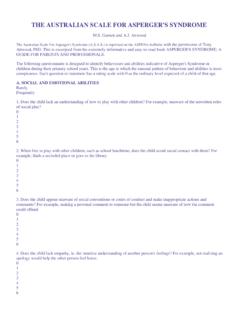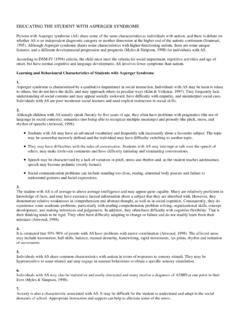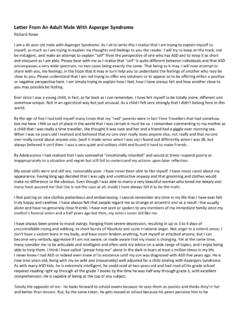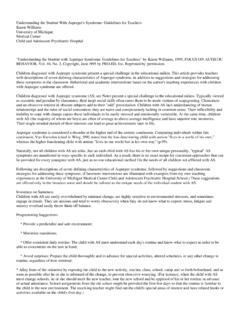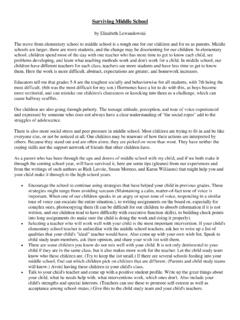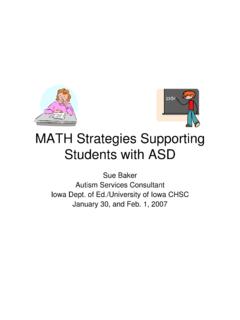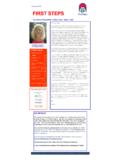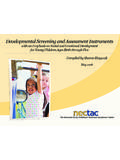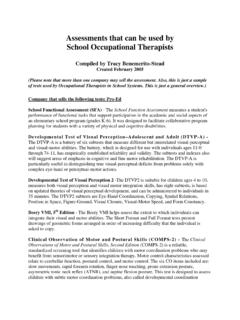Transcription of Asperger's Syndrome: Guidelines for Assesment …
1 Asperger's syndrome : Guidelines for Assesment and Diagnosisby Ami Klin, , and Fred R. Volkmar, Child Study Center, New Haven, by the Learning Disabilities Association of America, June 19954156 Library RoadPittsburgh, PA 15234(412) 341-1515 Introduction Asperger syndrome (AS) is a severe developmental disorder characterized by major difficulties in social interactioand restricted and unusual patterns of interest and behavior. There are many similarities with autism withoutretardation (or "Higher Functioning Autism"), and the issue of whether Asperger syndrome and Higher FunctioAutism are different conditions is not resolved.
2 To some extent, the answer to this question depends on the wclinicians and researcher make use of this diagnostic concept, since until recently there was no "official" definition ofAsperger syndrome . The lack of a consensual definition led to a great deal of confusion as researchers could ninterpret other researchers' findings, clinicians felt free to use the label based on their own interpretatimisinterpretations of what Asperger syndrome "really" meant, and parents were often faced with a diagnosis thnobody appeared to understand very well, and worse still, nobody appeared to know what to do about it.
3 Schoodistricts ere not aware of the condition, insurance carriers could not reimburse services provided on the basis"unofficial" diagnosis, and there was no published information providing parents and clinicians alike with guidelineon the meaning and implications of Asperger syndrome , including what should the diagnostic evaluation consist ofand what forms of treatment and interventions were warranted. This situation has changed somewhat since Asperger syndrome was made "official" in DSM-IV (APA, 1994)following a large international field trial involving over a thousand children and adolescents with autism and disorders (Volkmar et al.)
4 , 1994). The field trials revealed some evidence justifying the inclusion of Aspergersyndrome as a diagnostic category different from autism, under the overarching class of Pervasive DevelopmDisorders. More importantly, it established a consensual definition for the disorder which should serve as the frameof reference for all those using the diagnosis. However, the problems are far from over. Despite some new researleads, knowledge on Asperger syndrome is still very limited. For example, we don't really know how common it is,or the male/female ratio, or to what extent there may be genetic links increasing the likelihood of finding simconditions in family members.
5 Clearly, the work on Asperger syndrome , in regard to scientific research as well as in regard to service provision, only beginning. Parents are urged to use a great deal of caution and to adopt a critical approach toward informatiogiven to them. Ultimately, the diagnostic label - any label, does not summarize a person, and there is a need toconsider the individual's strengths and weaknesses, and to provide individualized intervention that will mee(adequately assessed and monitored) needs. That notwithstanding, we are left with the question of what is the natureof this puzzling social learning disability, how many people does it affect, and what can we do to help those affectedby it.
6 The following Guidelines summarize some of the information currently available on those questions. BackgroundAutism is the most widely recognized pervasive developmental disorder (PDD). Other diagnostic concepts witfeatures somewhat similar to autism have been less intensively studied, and their validity, apart from autismcontroversial. One of these conditions, termed Asperger syndrome (AS) was originally described by Hans Asper(1944, see Frith's translation, 1991) , who provided an account of a number of cases whose clinical featuresresembled Kanner's (1943) description of autism ( , problems with social interaction and communicatiocircumscribed and idiosyncratic patterns of interest).
7 However, Asperger's description differed from Kanner's inspeech was less commonly delayed, motor deficits were more common, the onset appeared to be somewhat later, andall the initial cases occurred only in boys. Asperger also suggested that similar problems could be observed inmembers, particularly fathers. This syndrome was essentially unknown in the English literature for many years. An influential review and series case reports by Lorna Wing (1981) increased interest in the condition, and since then both the usage of the termclinical practice and number of case reports and research studies have been steadily increasing.
8 The commondescribed clinical features of the syndrome include (a) paucity of empathy; (b) nave, inappropriate, one-sideinteraction, little ability to form friendships and consequent social isolation; (c) pedantic and monotonic speech; (dpoor nonverbal communication; (e) intense absorption in circumscribed topics such as the weather, facts aboutstations, railway tables or maps, which are learned in rote fashion and reflect poor understanding, conveyingimpression of eccentricity; and (f) clumsy and ill-coordinated movements and odd posture. Although Asperger originally reported the condition only in boys, reports of girls with the syndrome have noappeared.)
9 Nevertheless, boys are significantly more likely to be affected. Although most children with the confunction in the normal range of intelligence, some have been reported to be mildly retarded. The apparent onset ofthe condition, or at least its recognition, is probably somewhat later than autism; this may reflect the more prelanguage and cognitive abilities. It tends to be highly stable, and the higher intellectual skills observed suggest abetter long-term outcome than is typically observed in autism. Related Diagnostic Concepts Several similar diagnostic concepts originating from adult psychiatry, neuropsychology, neurology, and othdisciplines share, to a great degree, the phenomenological aspects of AS.
10 For example, Wolff and colleaguesdescribed a group of individuals with an abnormal pattern of behavior characterized by social isolation, rigiditythought and habits, and an unusual style of communication. This condition was named schizoid personality disorderin childhood. Unfortunately, a developmental account of this concept was not provided, making it difficult toascertain the extent to which the individuals described may have also exhibited autistic-like symptomatology earlyon in life. More generally, the understanding of AS as an unchanging personality trait fails to fully appredevelopmental aspects of the disorder which may prove to be of great importance for differential diagnosis.
